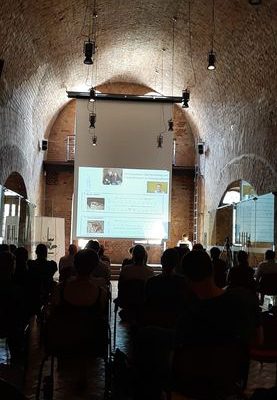

On 19/06/21 the first summer conference of the German Bat Observatory took place in the tranquil vaults in the Citadel Spandau (Berlin) in cooperation with the Berlin Species Protection Team (BAT e.V.) and the Working Group Applied Zoology and Nature Conservation of the University of Greifswald. The conference was held as a hybrid event, i.e. 50 bat friends met on site (in compliance with the applicable hygiene regulations) and ~ 100 participants were able to follow the lectures online. After the event, there was a small barbecue for the on-site participants with a midnight bath in the moat of the citadel. It was a nice conference with great contributions in a friendly atmosphere that will be remembered by us. Above all, we would like to thank all the speakers, but also the numerous participants, the organization team and the administration of the citadel, which generously supported us.
Due to the great demand in the aftermath of the conference, we provide the contents of the individual lectures here. In consultation with the speakers, you will find below either the live recording as a Youtube video,the presentation slides or a written summary of the lectures.
Sincerely,
the organizing team: Dr. Marcus Fritze, Dr. Nicole Starik, Jörg Harder, Brigitte Kaltofen, Robert Henning, PD Dr. Mirjam Knörnschild, Florian Gloza-Rausch, as well as other members of the Fledermauswarte, the BAT e.V. and the University of Greifswald
Block I: Digitalisierung und Analyse von Zähl- und Beringungsdaten
Marcus Fritze, Alexander Scheuerlein, Gerald Kerth: Endangered data of endangered species (Video)
Alexander Scheuerlein, Marcus Fritze, Gerald Kerth: Survival rates of bats based on ringing data (summary)
Since the 30s of the last century, starting from Eisentraut in Berlin, bats have been individually marked with metal rings and their quarters systematically controlled. Above all, the bat ringing center in Dresden (new federal states) but also the Museum Alexander König in Bonn (old federal states) have coordinated and archived the activities of the individual Beringers. Here is a brief overview of the extremely dynamic development of ring data analysis. In the context of these explanations it should be shown that the expert knowledge of the Beringer on site is indispensable in order to be able to provide precise estimators of population parameters such as survival rate and reproduction rate. In the 40s, the biostatisticians Jolly, Seber and Cormack developed without knowing about each other the theoretical foundations of the simultaneous estimation of survival and rescatch rates. Previously, uncaptured animals were considered dead. Re-catches at a later date were ignored. Especially through clever parameterization, precise estimates of the survival rate could be achieved under certain assumptions if at least 3 times of the controls were available. However, the method was computationally quite complex at the time, so that only a few used the method. It was not until 1992, with the publication of Lebreton et al in Ecological Monographs and the development of the software programs of Mark and mSurge, that the stone of “Mark Recapture” analyses got rolling, and the Cormack Jolly Seber methods became more pre-found worldwide. Together with the Mark Recapture analyses, the modern statistical methods of “model selection” were also transferred to the general canon of methods of conservationists and nature managers with the help of the AIC criterion. With the help of the AIC criterion, a measure from information technology, those models are selected that explain as much of the variance in the data as possible with as few parameters as possible. Especially in this process of model selection, the previous knowledge of the Beringer is essential to incorporate biologically relevant (and later interpretable) parameters into the models. Recent developments, especially in computing capacities since the turn of the millennium, make it possible to drive more and more models with Bayesian statistics. With these models, more complex models with hierarchical variable structures can be calculated. Thus, the rather complex colony structures of forest bats (e.g. M.bechsteinii and M. nattererii)can be integrated into models that estimate both survival rates and reproduction rates.
Note: The work contains unpublished, preliminary data and will be communicated accordingly after publication.
Reinhard Klenke, Ulrich Zöphel: Population trends and demography of bat species based on ringing data (PDF)
Klenke_Reinhard_FlmMark_iDiv20210619_VO_svBlock II: Lichtverschmutzung
Florian Gloza-Rausch: Bats and Light – Examples from Nature Conservation Practice(Video)
Jörg Harder: Fledermausquartier Zitadelle Spandau with hints on artificial lighting (Video)
Block III: Bioakustik
Nicole Starik: Interesting facts about the use of open source technologies for the acoustic monitoring of bats (Video)
Eric Jansen, V. Hommersen, M. van Oene, E. Korsten, H. Limpens, M.Schillemans, T. v.d. Meij, J. van Zweden: Zum Fledermausmonitoring in den Niederlande und insbesondere zu akustischen Transektzählungen (Video)
Charlotte Roemer, Christian Kerbiriou, Jean-François Julien & Yves Bas: Citizens and machines monitor bats together: lessons from 15 years of acoustic monitoring in France (Video)
Martin Koch: Internet of Bats (PDF)
2021_Koch_Internet_der_FledermaeuseBlock IV: Telemetrie
Simon Ripperger: Wireless sensor networks provide new insights into the social life of bats (Video)
Ralf Hurst: Telemetry 4.0 (Video)
Manuel Roeleke: Old questions, modern methods: New insights through GPS and co (PDF)
Roeleke_publicBlock V: Lichtschranken
Karl Kugelschafter: Inventory monitoring using bat light barrier systems (Video)
Gabriella Krivek, Gerald Kerth, Jaap van Schaik: Stört der Blitz? und automatische Arterkennung von Kamerafallenbildern (Summary)
Summary: At winter quarters, camera traps with white flash light can provide an efficient alternative method for monitoring endangered bat species, but the possible negative influence of white flash on bat behavior is unknown. In a 16-week experiment, we investigated the effect of white flash light on four winter quarters equipped with a camera trap triggered by an infrared light barrier, an infrared video camera and an acoustic recorder. At each location, the white camera trap flash was turned off every other week. In detail, we quantified whether the flash light 1) the nocturnal bat transits, 2) the direction of flight of the flying bats and 3) affected the latency of the first echolocation call after triggering the camera trap. In addition, the possible influence of confounding factors such as weather and social interactions was quantified and included in the analysis. Overall, the white flash had no effect on short- or long-term bat activity, flight direction, or echolocation behavior. A decrease in nocturnal bat activity was observed only with an increasing proportion of rainy hours. In addition, the direction of flight was influenced by the presence of other bats, probably due to tracking and avoidance behavior. Our results highlight the potential of camera traps with white flash triggered by infrared light barriers as a minimally invasive method for long-term monitoring of bat populations and for studying species-specific phenology. Such automated monitoring technologies can improve our understanding of long-term population dynamics across a wide range of spatio-temporal scales and taxa, and consequently contribute to data-driven wildlife conservation and management.
Note: The work is currently being reviewed and will be communicated accordingly after publication.
